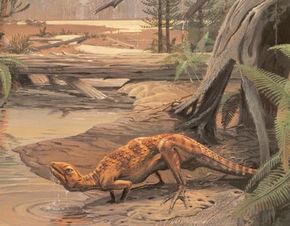SCUTELLOSAURUS (skoo-TELL-oh-SORE-us)
Period: Late Triassic
Advertisement
Order, Suborder, Family: Ornithischia, Ornithopoda, Fabrosauridae
Location: North America (United States)
Length: 4 feet (1.2 meters)
One of the earliest ornithischian dinosaurs, Scutellosaurus is unusual because it was a two-legged dinosaur with armor. While most armored dinosaurs were large quadrupeds (they walked on four legs), Scutellosaurus was small, about the size of a collie dog. The skull bones were slender, like other members of this family. The jaws were strong with powerful muscles. The animal had bladelike front teeth that were used for grabbing or nipping at plants. The teeth on the sides of the jaws were pointed, with tiny ridges on the sides that helped slice its food.
The front legs were strong for a biped. The front feet were also relatively large, showing that it often used its front legs for walking. Because of the bony armor, these little dinosaurs were heavy, so that movement on all fours was comfortable when they were resting or moving slowly. The tail was strong and probably useful not only when it was moving but also to defend it-self against predators. The rear legs were well suited for bipedal motion, and the extra long tail balanced the animal when it walked on its back legs.
The unusual feature of Scutellosaurus, or "shield reptile," is the presence of several hundred small bony plates (scutes) in the skin, probably covering the neck, back, ribs, and tail. These scutes were isolated and similar to the bony plates of alligators and crocodiles. In Scutellosaurus these plates were small; the largest was about the size of a quarter. Some flattened plates, though they were much smaller, were similar to the plates of Ankylosaurus.
Scutellosaurus had other plates that were tall and triangular, roughly similar to those of Stegosaurus. The function of the plates of Scutellosaurus was probably different from Stegosaurus, which was much larger and needed its plates to regulate its body heat. Scutellosaurus was small and did not need this. Instead, its plates probably protected its pelvic area, and the other armor probably protected its skin from coarse vegetation, much like modern-day armadillos.
Because of the armor and the overall form of the body, some paleontologists think Scutellosaurus was the ancestor of the later large armored dinosaurs, such as Stegosaurus and Ankylosaurus. In these Late Jurassic and Cretaceous species, the armor was heavy, so the animals always had to walk on all four feet. However, their front legs were short, showing the ancestry of the Early Jurassic dinosaurs that were small and bipedal.
A relative of Scutellosaurus was Lesothosaurus from South Africa, from approximately the same age. This little dinosaur lacked armor and had smaller front legs, showing that it more often used only its back legs to walk or run.
Advertisement
